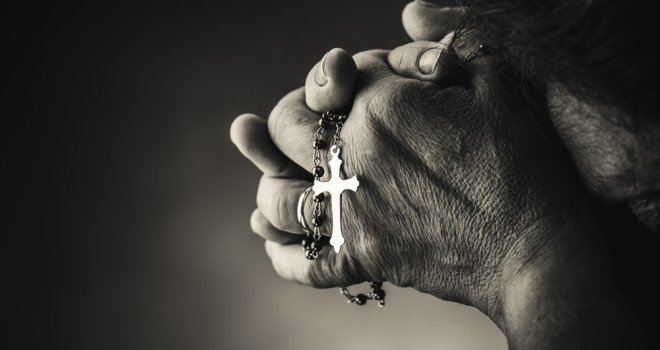In 2016, two weeks after it was legalized in Canada, a patient asked for my help in referring her for Medical Assistance in Dying (MAiD). As a registered nurse visiting the sick and the dying in their homes, my responsibility was to report her request to her family doctor as well as to her community’s healthcare provider.
“Why do you want to die?” I asked, disturbed by the request. The patient, a lapsed Catholic, tearfully explained using laboured gestures and markedly slurred speech that she no longer wanted to live with her losses and daily struggles. She had suffered a stroke that impaired both her speech and mobility, and that exacerbated already existing health challenges. “I want to die,” she repeated.
“I can’t do that,” I replied. “I am a practicing Catholic. I believe euthanasia and assisted suicide are wrong. I won’t refer you but I will do everything I can to get the homecare support you need. And I will pray for you.”
The patient continued crying, sobbing into my shoulder as I held her. She never asked for another MAiD referral. One year later she died at home with the support she needed to live out her life with Christian dignity. In that year, she did not reconcile with God and His Church, not outwardly anyway, but I believe that the peace that came over her in her final days was God’s mercy working on her.
As MAiD has become more accepted since its legislation, even some Catholic patients and their families have moved in line with its alarming rise in approval. In a conversation with a practising Catholic patient, I was asked to advise her on how to arrange for MAiD. At the same time, she asked me how to give a substantial donation to her parish before her medically approved euthanasia.
Refusing to assist her, I reminded her that killing, including her own, was a mortal sin. Her response was typical of people who choose MAiD: “it’s my life and I’ll do what I want with it. The Church can’t tell me what to do. I have no one left and I am always in pain. This is not how I planned to live my life.”
Often, patients choose to die because they do not want to experience the inevitable loss of independence, self-sufficiency and autonomy that comes with the progression of life-limiting illnesses. A patient in the early stages of Amyotrophic Lateral Sclerosis (ALS), chose MAiD, dying at home from a lethal cocktail of drugs administered by a relative who is a physician. So accepted by the family was her choice to end her life that her teenage grandchildren were present as the deed was done.
A few weeks later in a follow-up visit with her husband, he asked me if I was Catholic. He explained that he was once a Catholic but no longer believed in God. But then he asked, “do you think she is in heaven?”
“I don’t know,” I quietly replied. “Although her death went against the Commandments, I believe in God’s mercy. Only God knows your wife’s heart at the moment of her death. Only God can judge what happened here. I know you don’t believe but I think you need to pray for her and commend her to the mercy of God.” With tears in his eyes and unable to speak, he quietly nodded.
While this husband showed a sense of remorse about his late wife’s decision to have herself killed, as well as his support of it, other families have vigorously defended their loved one’s solution to die with medical assistance.
“What choice did he have?” insisted the mother of a young man who found living with a neurodegenerative disease too much to bear. “He was going to die anyway. What kind of life did he have?”
As well, family members are afraid of the burden of care that will fall to them as the patient’s condition takes its natural course. It is not uncommon for family members, including some Catholic families, to convince their seriously ill loved one that MAiD is the solution to their suffering.
MAiD has become more accepted for many reasons. People are fearful of losing their independence, becoming reliant on others for their most basic human needs, living alone and lonely, experiencing physical pain, mental anguish, becoming a burden, losing their perceived dignity. Every reason I have heard falls within one or more of these areas. An observation I have made is that people are afraid of suffering. They don’t understand it. They see no value in it.
Our clergy have failed us by their continuing neglect teaching generations of Catholics about the inherent value and dignity of suffering. Suffering is salvific. It brings us closer to Christ, sharing in His passion for the salvation of the world. It glorifies God. “Your sufferings, accepted and borne with unshakable faith, when joined to those of Christ take on extraordinary value for the life of the Church and the good of humanity.”(Apostolic letter, Salvifici Doloris, Pope John Paul II) Often when I encourage my patients that there is a purpose and dignity in their suffering, I am met with a lack of acceptance and understanding, even among Catholic patients who have forgotten this aspect of their faith or who no longer believe it because they have not heard it from the clergy.
According to Health Canada’s Third Annual Report from 2021 on Medical Assistance in Dying in Canada, 10,064 Canadians chose death by MAiD in 2021. Recently, I watched a YouTube video that used faceless actors to demonstrate how MAiD is performed in Canada. With its soft music, comforting ambience, compassion shown by the actors, the video will go a long way in normalizing what is now considered a medical option. The demonstration is pure propaganda, a soft-sell for legal killing. Even our church leaders have conceded that MAiD is here to stay.
Does that mean we should give up? Do we allow ourselves to be swallowed up by the culture of death? After showing the YouTube video to my spiritual director, he responded that it is time for Catholics to form communities “if we wish to survive in any communal manner.” Among other things, that means we need to work towards a way to assist the sick and the dying in a truly Catholic way, upholding the Christ-given dignity of every person. It is time to establish authentically Catholic healthcare that upholds the dignity of life. Impossible? Perhaps if we rely on our human abilities. But not with God, for with Him all things are possible in His time.
In his Apostolic Letter, Salvifici Doloris, Pope John Paul II refers to the Good Samaritan, using the parable to insist on the compassionate work of caring for the suffering among us. He reminds us of Christ’s teaching of the Final Judgment: “Truly, I say to you, as you did it to one of the least of these my brethren, you did it to me.” He expands on Christ’s Word by explaining that “the opposite sentence will be imposed on those who have behaved differently.”
Salvifici Doloris teaches us that like the Good Samaritan, with compassion for the suffering of our neighbour, we have to “give some help.” How best can we do this if not in Catholic facilities that truly hear and act on the Word of God.
On the Christian Meaning of Human Suffering: Apostolic Letter Salvifici Doloris of the Supreme Pontiff John Paul II












